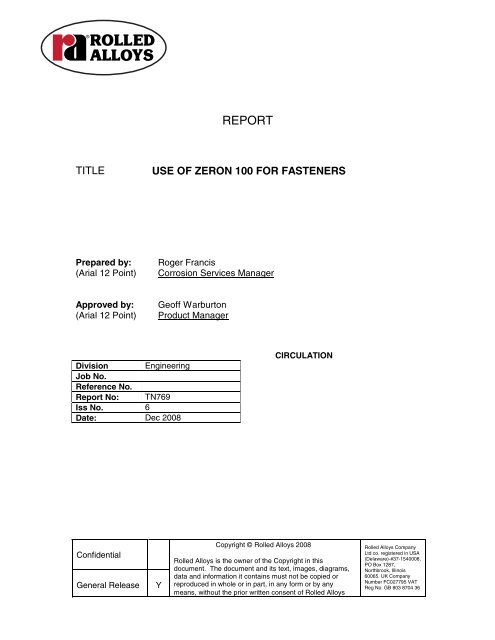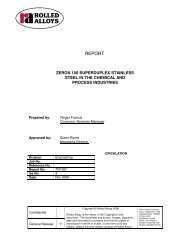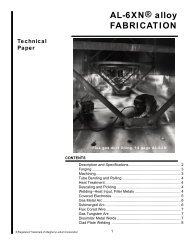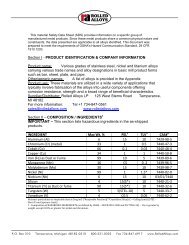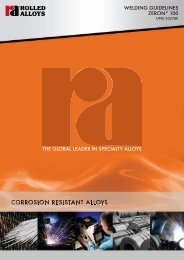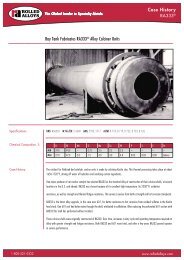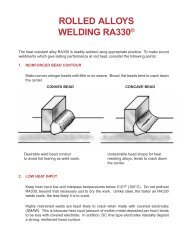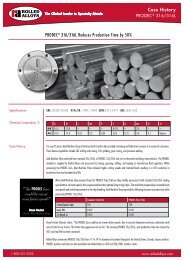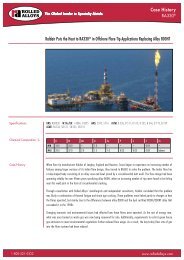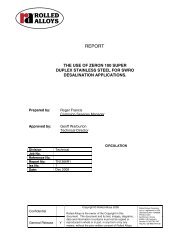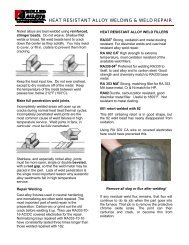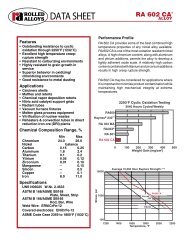ZERON 100 Fasteners - Rolled Alloys
ZERON 100 Fasteners - Rolled Alloys
ZERON 100 Fasteners - Rolled Alloys
You also want an ePaper? Increase the reach of your titles
YUMPU automatically turns print PDFs into web optimized ePapers that Google loves.
REPORTTITLEUSE OF <strong>ZERON</strong> <strong>100</strong> FOR FASTENERSPrepared by:(Arial 12 Point)Roger FrancisCorrosion Services ManagerApproved by:(Arial 12 Point)Geoff WarburtonProduct ManagerDivision EngineeringJob No.Reference No.Report No: TN769Iss No. 6Date: Dec 2008CIRCULATIONConfidentialGeneral ReleaseYCopyright © <strong>Rolled</strong> <strong>Alloys</strong> 2008<strong>Rolled</strong> <strong>Alloys</strong> is the owner of the Copyright in thisdocument. The document and its text, images, diagrams,data and information it contains must not be copied orreproduced in whole or in part, in any form or by anymeans, without the prior written consent of <strong>Rolled</strong> <strong>Alloys</strong><strong>Rolled</strong> <strong>Alloys</strong> CompanyLtd co. registered in USA(Delaware)-#37-1540008,PO Box 1287,Northbrook, Illinois60065. UK CompanyNumber FC027795 VATReg No. GB 803 8704 36
USE OF <strong>ZERON</strong> <strong>100</strong> FOR FASTENERSTABLE OF CONTENTSSECTIONDESCRIPTIONSUMMARY1.02.03.04.0INTRODUCTIONAPPLICATIONSGALLINGCONCLUSIONSREFERENCESAPPENDICESAppendix 1Summary of Properties of Zeron <strong>100</strong> for <strong>Fasteners</strong>.Copyright © <strong>Rolled</strong> <strong>Alloys</strong> 2008Report No. TN769Issue No. 6Page 2 of 9
SUMMARYThis report describes the fasteners available in Zeron <strong>100</strong>, and how they can be used to avoidproblems of galvanic corrosion of carbon steel and 316 stainless bolts used with high alloystainless steel piping/flanges.Copyright © <strong>Rolled</strong> <strong>Alloys</strong> 2008Report No. TN769Issue No. 6Page 3 of 9
When fasteners are used subsea they will often be exposed to the cathodic protectionwhich is applied to the rest of the subsea structure. This is typically ~ -1V SCE, andconcern has been expressed about the potential for hydrogen embrittlement of duplexstainless steel fasteners. WM&F have been supplying Zeron <strong>100</strong> fasteners since 1990and have yet to see a failure by any corrosion mechanism, including hydrogenembrittlement. Failures of high strength 25% Cr duplex stainless steel fasteners undercathodic protection have occurred 1 , but the high strength had been achieved by ageing.Ageing has been shown to greatly increase the susceptibility of duplex stainless steels tohydrogen embrittlement 1 . The high strength of Zeron <strong>100</strong> FG and FLT grades is achievedby light cold work. Research by TWI 2 has shown that the threshold stress for the initiationof hydrogen embrittlement cracks is around the 0.2% proof stress. The recommendationfor loading bolts is usually between 60% and 70% of the proof stress. At these levels ofstressing, cracking due to hydrogen embrittlement will not occur.Zeron <strong>100</strong> fasteners can be used not only with Zeron <strong>100</strong> pipes and flanges, but also withother high alloy, corrosion resistant alloys. These include other superduplex alloys, 6%Moaustenitic stainless steels, and nickel-base alloys such as alloys 625 and C-276.Zeron <strong>100</strong> fasteners have been used in a wide variety of applications where corrosionresistance is importance. The alloy has been used for attaching the buoyancy moduleson subsea risers on several offshore platforms, as shown in Figures 1 and 2. Zeron <strong>100</strong>has also been used to anchor rubber fenders to concrete docks in a Middle East harbour(Figure 3). Weir Materials and Foundries supplied two quarter mile stretches of castZeron <strong>100</strong> tunnel lining to London Underground, where the local groundwater was veryacidic, due to microbial action, and contained high levels of chloride. The cast sectionswere all fastened together with Zeron <strong>100</strong> bolts, as were the assembled rings (Figure 4).3.0 GALLINGGalling is often assumed to be a problem with stainless steels. The problem istraditionally associated with 300 series austenitic alloys. Galling is less of a problem withmore highly alloyed austenitic and duplex alloys. Bar in Zeron <strong>100</strong> SA for nuts, is suppliedin the solution annealed condition. This typically has a hardness of 50HV less than that ofcold worked FG and FLT material. This minimises the risk of galling. Zeron <strong>100</strong> boltshave been used for many years in submersible marine pumps and it is common practiceto coat fasteners with ~6µm of copper. This is produced by electroplating and is usuallyapplied to the male stud. This is to ensure ease in dismantling for servicing of the pumps.In critical applications, where very high torques are required, successful use has beenreported of conventional anti-galling sprays (e.g. Rocol), copper-loaded greases, andPTFE coatings. The use of molybdenum disulphide lubricant should be avoided forelevated temperature service, because of the risk of decomposition of the lubricantleading to sulphide attack.4.0 CONCLUSIONSThe use of Zeron <strong>100</strong> fasteners provides a corrosion resistant bolting material thatovercomes the galvanic corrosion problems which can occur with less corrosion resistantfastener materials, such as carbon steel and 316L.Copyright © <strong>Rolled</strong> <strong>Alloys</strong> 2008Report No. TN769Issue No. 6Page 5 of 9
References1. R. Francis, G. Byrne and G. R. WarburtonCorrosion 53 (1997) 234.2. P. Woollin and A. Gregori, “Avoiding Hydrogen Embrittlement Stress CorrosionCracking of Ferritic Austenitic Stainless Steels Under Cathodic Protection”,OMAE 2004 – 51203. 23rd Int. Conference on Offshore Mechanics and ArcticEngineering, Vancouver, Canada, June 2004.Figure 1 Zeron <strong>100</strong> fasteners for locating buoyancy modules on an offshore riser.Copyright © <strong>Rolled</strong> <strong>Alloys</strong> 2008Report No. TN769Issue No. 6Page 6 of 9
FIGURE 2 Deployment of riser with buoyancy modules.Copyright © <strong>Rolled</strong> <strong>Alloys</strong> 2008Report No. TN769Issue No. 6Page 7 of 9
FIGURE 3 Zeron <strong>100</strong> fasteners attaching rubber fenders on a Middle East dock.FIGURE 4 LUL tunnel linings fastened with Zeron <strong>100</strong> bolts.Copyright © <strong>Rolled</strong> <strong>Alloys</strong> 2008Report No. TN769Issue No. 6Page 8 of 9
Appendix 1SUMMARY OF PROPERTIES OF <strong>ZERON</strong> <strong>100</strong> FOR FASTENERSBOLTING BAR GRADES – MINIMUM MECHANICAL PROPERTIESGradeYieldStrength(0.2% offset)MPa (ksi)TensileStrengthMPa (ksi)Elongationin 50mm(%)Reductionof Area(%)CharpyV-notchImpactEnergyZeron <strong>100</strong>SA550 (80) < 90mm: 800 (116)> 90mm: 750 (109)25 50 70J (51ft.lbf) meanat -46°C (-50°F)Zeron <strong>100</strong>FGZeron <strong>100</strong>FLT725 (105) 860 (125) 16 50 40J (30ft.lbf) meanat -46°C (-50°F)725 (105) 860 (125) 16 50 27J (20ft.lbf) meanat -101°C (-150°F)<strong>ZERON</strong> <strong>100</strong> SA - Maximum 28 HRC, meets NACE MR0103-2005 for the solution annealedcondition.<strong>ZERON</strong> <strong>100</strong> FG – Tensile properties of ASTM A193-B7, plus Charpy impacts, maximum36 HRC meets NACE MR0175/ISO 15156-3 for the solution annealed & cold worked condition.<strong>ZERON</strong> <strong>100</strong> FLT – Tensile and Charpy impact properties of ASTM A320-L7, maximum 36 HRCmeets NACE MR0175/ISO 15156-3 for the solution annealed & cold worked condition. .NUTS For SA Bolts - SA conditionFor FG Bolts - SA conditionFor FLT Bolts - SA conditionMANUFACTURING ROUTE - SA bolting can be forged and solution annealedprior to final testing, or machined from SA bar.- FG and FLT bolting must be machined from theappropriate grade of bar.Copyright © <strong>Rolled</strong> <strong>Alloys</strong> 2008Report No. TN769Issue No. 6Page 9 of 9


